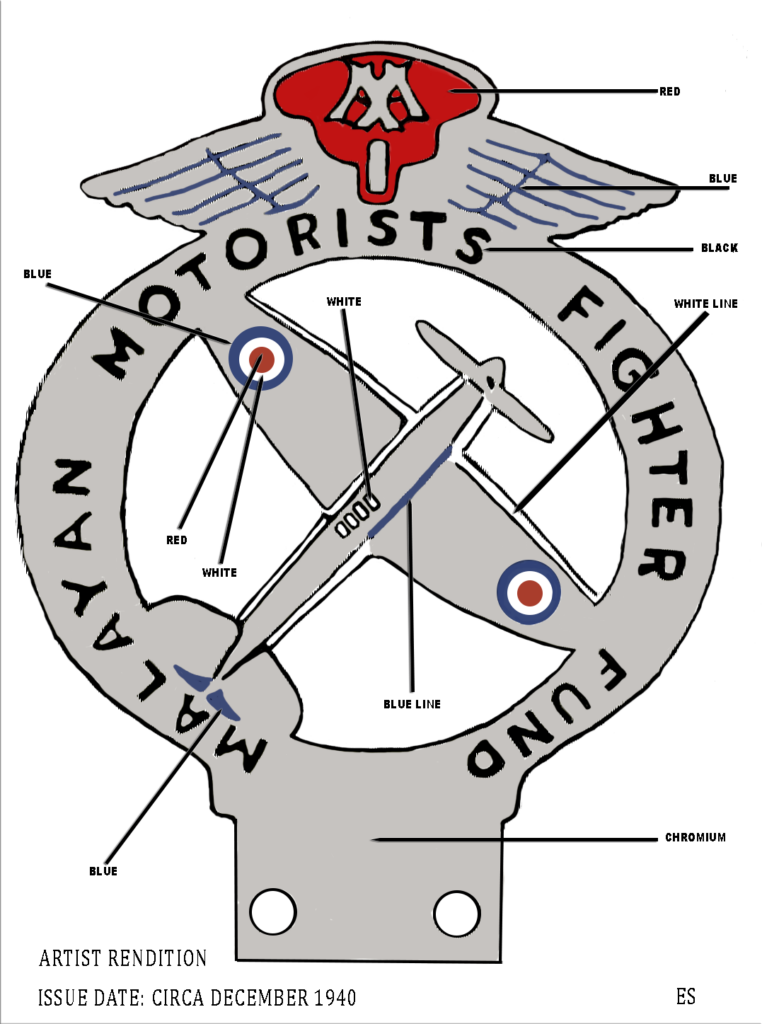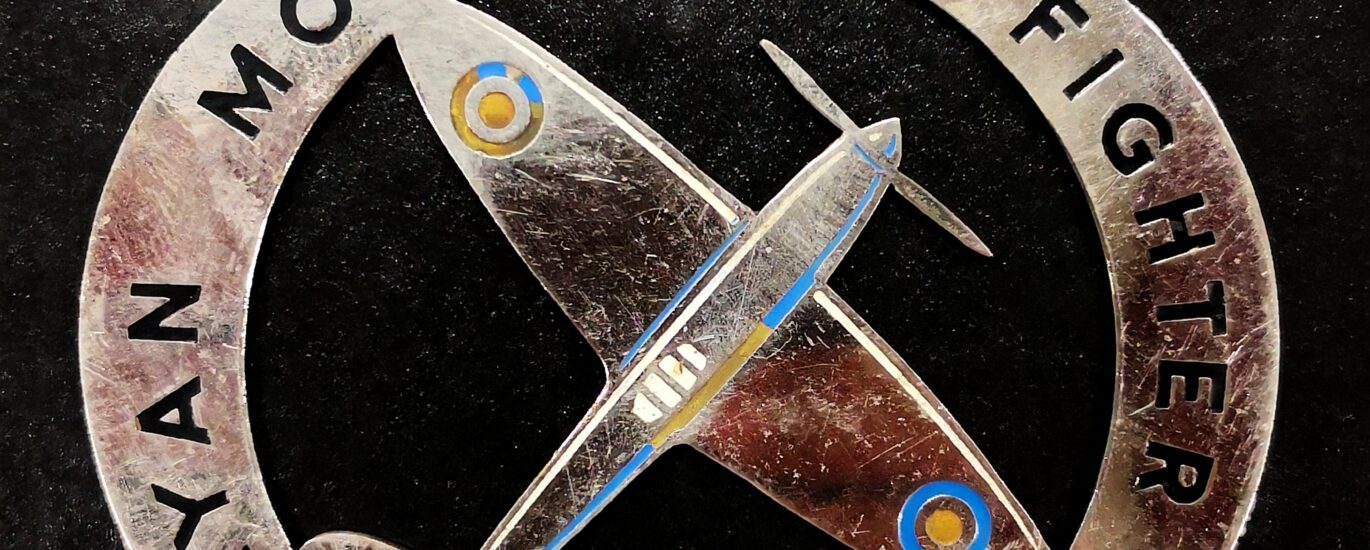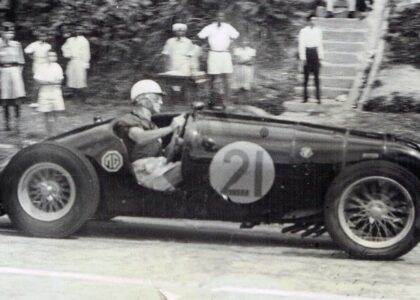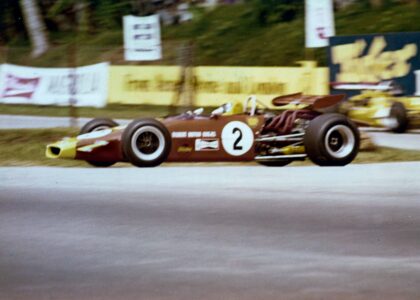A Rare Car Badge
Car grille badges were a big thing until the advent of the modern car grille – a non-existent piece of plastic that discourages the placement of such metal/brass objets d’art. Such badges served a purpose, a sign of membership to an association/club or a medical doctor, for example. Placement on old radiator grilles eventually became decorative. That, in short, is what a grille badge is all about. Some fetch good money in the collector market as cherished automobilia, the rarer ones never seeing daylight on a car radiator grille of a vintage automobile, unless one if prepared to risk exposure to the elements (or risk it stolen).
After over 20 years of searching, a badge I have always coveted showed up on my radars with a dealer in memorabilia in Australia.
WhoDaThot a meaningless (today) badge could merit blog space…

Artist’s rendition of the first iteration of the Automobile Association of Malaya’s Malayan Motorists Fighter Fund badge showing colors on the chrome plate. The final iteration, decided by the AAM’s Executive Committee in August 1941, incorporated a “V” atop the AAM crest.
FIGHTER FUND: One of the last acts of the Automobile Association of Malaya’s Central Office before the Japanese successfully invaded Malaya was a donation to Britain’s War Fund. It took place on the 11 February 1942 and amounted to a sum of $759.96, being “the balance in hand of the Malayan Motorists’ Fighter Fund.” Four days later, Singapore capitulated.
What was that last donation for? The AAM had manufactured vehicle badges of two sizes, called Malayan Motorists’ Fighter Fund badges. They were priced at $10 & $5, were well-designed and while very rare item today, was made even rarer by the secondary issue of another version with a “V” at the top (a $1 top-up was necessary to purchase this badge). More on that later. The proceeds from the sale of these badges were used to purchase a fighter plane for the motherland, the funds going to Home Government. No, not for the defense of Malaya but for Britain.
ON THE ROAD: First references to the availability of these badges appeared in the local papers on 21 December 1940[1], well before the clouds of war hung over Malaya. In fact, the fact that this was nearly a month after the Johore War Effort Grand Prix [to be shortly featured in another post in this website] meant that racing was still fresh on the minds of motor racing enthusiasts so donation expectations must have been high.
In fact, the first badge was sold in Selangor on 20 December 1940 – not for $10 but for a very generous $500! In two sizes and priced accordingly, they were available at leading stores throughout Malaya and Singapore, at clubs, motor garages, etc,. Who came up with this idea of selling car badges to raise money to buy a fighter plane for the home government is moot. Some point to a member of the South Johore branch of the Incorporated Society of Planters[2], some credit John Wishart[3], one of the founding members of the AAM. In January 1941, James McEvoy[4], Penang’s Registrar of Vehicles said that the selling of badges in aid of a fighter fund was originated by one of AAM’s members from Seremban, crediting Wishart for the idea.
By 7 January 1941 this fund-raising scheme was referred to as the Malayan Motorists’ Spitfire Fund, the monies to be set aside for the purchase of a Supermarine Spitfire. The logic was simple. There were 43,000 vehicles on Malayan roads in 1939, of which 30,998 were private vehicles. If half of these bought the cheaper of the two badges, the AAM would have raised Malayan $154,990, or the equivalent of £18,080 at the time (Malayan $60 being equal to 7 British Pounds). They optimistically figured it would be enough to purchase of two fighter planes for the RAF, though demand wasn’t that robust.
In the Singapore Free Press, 19 July 1941: Local Motorists’ Fund To Buy Fighter Plane – SPECIAL EFFORT TO-DAY article states a Fighter Badge will be offered for sale at an exhibition of “striking photographs of fighter planes, lent by the Ministry of Information…” The exhibition display was in the window of the British Dispensary in Raffles Place.
ADDENDUM: To add a twist to the story, the Morning Tribune papers (2 September 1941)[5] revealed that a new badge had been launched – with a V added on top, presumably above the AA insignia. Old badges could be exchanged for the new one, for an additional payment of just $1. The decision to come up with a new version was made at the AAM executive council meeting in KL on 17 August 1941.
At the close of business on 12 February 1942, the AAM had raised $48,759.96 from badge sales/donations. This, and the fact that a majority of the vehicles were either destroyed or butchered during the war, might account for the scarcity of this badge today.
IN THE AIR: The Spitfire purchased from the AAM’s donation was named “Gerda”*. B.L.444 became a member of the Eagle Squadron and was dispatched from No. 6 Maintenance Unit to No.133 Squadron for battle baptism in December 1941. This Squadron was under the command of Squadron Leader G.A. Brown. In early 1942, Gerda was sent to No. 74 Squadron, under Squadron Leader P. Matthews. The aircraft was in service for two months before an accident ended its operational career. Officially it was listed as Disbanded, 29 September 1942. B.L.444 was a Mk Vb and had a Rolls Royce Merlin M45 engine and was built at the CBAF factory (Castle Bromwich Aircraft Factory).[6]
* This, the authorities incorrectly revealed, was a royal eagle in Malay. In fact, Sir Roland Braddell explained in JMBRAS Vol. XV Part III (December 1937) – An An Introduction to the Study of Ancient Times In the Malay Peninsula and The Straits of Malacca – was in fact the mighty Garuda, Vishnu’s mythical bird.
[1] Straits Times, 21 December 1940.
[2] The Incorporated Society of Planters Car Club – The ISPC was a pan-Malayan club with membership restricted to those already members of the Incorporate Society of Planters. An annual dance and concours d’Elegance and rallies were what the club generally organised. The Society’s monthly magazine, The Planter, generally ran a motoring article in each of its edition.
[3]John Wishart [b. 22.2 1896] was Chief Health Inspector, Kinta Sanitary Board in September 1939. He became Chief Sanitary Inspector and Registrar of Vehicles, Seremban in March 1937. He was still Chief Sanitary Inspector and Registrar of Motor Vehicles and President of the Negri Sembilan Branch of the AAM in January 1938. He was also chieftain of the N.S. Branch, St. Andrew’s Society. He was back in Malaya post-war, and was Chairman of the N.S. and Malacca Branch of the AAM when it held its first post-war road speed trial in June 1949. He had been re-elected Chairman of the branch. His Vice-Chairman was fellow racing enthusiast, Wearne Brothers’ Seremban Manager, Harry Gordon Hinds.
[4] James Arthur McEvoy [b. ? d – 13.12 1964] came to Malaya circa 1920s. Was married by 1930. Wife was Gladys. They had a daughter in Penang on 3 August 1930. McEvoy was on the Committee of the Penang and Kedah Branch of the AAM at the AAM’s meeting held at the offices of the Secretaries of the Selangor AAM at the end of February 1932. He and Gladys had a son on 19 May 1932, in Penang. He became the Registrar of Vehicles 1 July 1932. Prior to that McEvoy was with the Straits Java Trading Company. He also became the Secretary of the Penang and Kedah Branch of the AAM. Penang. During the war, McEvoy was a Captain A [Depot] Company, 3SSVF and was a POW in Changi.
[5] The Morning Tribune was the morning edition of the Malaya Tribune newspapers. The Malaya Tribune started in 1914 and targeted Asia readers. Interestingly, the Tribune’s establishment was in part due to the efforts of Dr Lim Boon Keng (note: father of racer Lim Peng Han) and his contemporaries. The Tribune became known as the “People’s Paper” (C.M. Turnbull, Dateline Singapore, p.70). It was also dismissed as the kerani’s (clerk in Malay) paper. By the 1930s, the Malaya Tribune was actually challenging the supremacy of the Straits Times. The Morning Tribune was launched in February 1936, a 20-page paper soon enlarged to 24 pages and priced well below the other newspaper papers (at just 5 cents). Interestingly, the Malaya Tribune published its last pre-war edition on 11 February 1942, its offices having received a direct hit during air raids in early February, though management of the main and morning editions had moved their equipment home and continued to print until the 11th.
[6] Supermarine Spitfire BL444 Mk Vb, Built at Castle Bromwich Aircraft Factory. Delivered to No 6 MU 27-12-41, assigned to 133S 5-1-42, transferred to 74S 26-1-42, FA Cat CB 20-3-42.



